You found {{ resultCount }} results!
Sorry, we didn't find a result for you!
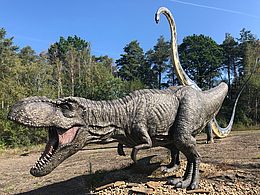
Dinosaur footprints and reconstructions
The Dinosaur Park in Münchehagen is a museum to experience, touch and explore. It is not only an amusement park, but also an open-air museum and Germany's largest scientific adventure theme park. With over 230 lifelike dinosaur reconstructions, the evolution of prehistoric animals in the history of the earth is depicted. With a length of 45 meters and a height of 9 meters, the gigantic Seismosaurus is larger than a double-decker bus and the largest Dinosaur in the park. Of course, one also encounters the Triceratops, the Brachiosaurus and, of course, the fearsome Tyrannosaurus Rex.
The park's scientific heart is the Dinosaur Tracks, the actual footprints and trails of dinosaurs that were uncovered here. In the conservation workshops original dinosaur bones are preserved in front of spectators.
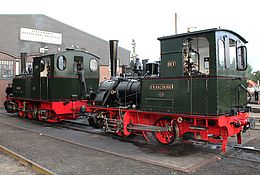
Pure nostalgia
In 1892, small railways were built to open up remote areas. These are still partially preserved today and invite people of all ages on discovery trips. A rail tour offers the eye many picturesque views. Inside, conductors wear red caps and dark blue uniforms. Outside, semaphore signals raise their arm in the air and the distinctive whistling sound of the steam engine announces that a train is coming.
The Bruchhausen-Vilsen museum railway is Germany’s oldest open-air railway museum with more than 100 rail vehicles and narrow-gauge steam locomotives that run between Bruchhausen-Vilsen and Asendorf. Further museum railways are the Pingelheini, the Kaffkieker as well as the Uchte Rahden Museum railroad (historical rail busses). In Kirchweyher station is a steam locomotive from 1941, which commemorates the history of the Weyher railway (one of the largest marshalling yards in northern Germany).

A historic city with halb-timbered buildings
Right in the middle - between the cities of Hannover and Bremen - lies the city of Nienburg directly on the Weser, the economic and cultural center of the Middle Weser. The heart of the historic city, with its 1000-year history, is the old town full of beautiful half-timbered buildings, Renaissance facades and brickwork. Here is also the Nienburg Townhall (Rathaus), a magnificent building from the time of the Weser Renaissance. The main church of Nienburg, a three-aisled hall church in the North German brick Gothic style, was consecrated in 1441. The 72 m high church tower, a neo-Gothic addition, is the landmark of the city and was built in 1896/97. Probably the oldest building in the city is the Stockturm. It is the remnant of the former moated castle of the Counts of Hoya. The tower was used as a prison by Napoleon’s troops; and prisoners sat "in the stocks" here.
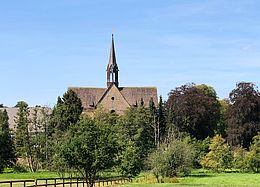
Cistercian monastery built in 1163
"The door is open, the heart even more" is the sonorous slogan of the monks of the Monastery of Loccum. A visit to the religious house built in 1163 proves the motto and lets the guest travel back in time. Unique in its effect, it still gives the impression of a medieval Cistercian monastery. The attractive environment with ponds and forest, on the other hand, owes its effect to the landscaping of the early 19th century. The monastery, which was founded in what was then deep (and marshy) solitude, is still very much alive today in several respects: in addition to the conference center, the monastery now houses a Protestant seminary, and continues to serve as an internationally renowned venue for specialist conferences.
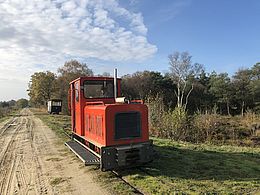
Moor track in the Great Uchter Moor
With a total length of more than ten kilometers, the moor track in the Great Uchter Moor has the longest route network of similar railways in Lower Saxony. You travel carefree by train through the 3263 hectare nature reserve and get to know the moor in a unique way on the approximately 2-hour journey. The train station is in Essern (rides Sundays, April to October). The exhibition also includes the engine shed and the information center "Gateway to the Moor." The exhibition provides information on moorland and peat, as well as displaying the remains of ‘Moora’, a body lost in the bog 2,600 years ago.

Tours an trips on boads on the river
Just let your legs dangle and enjoy the natural landscape of the Middle Weser region from the water. A boat ride is certainly one of the most beautiful and relaxed ways to travel through the Moor, Heath and Geest lands of the Middle Weser region. The Nienburg boat company travels the Weser between Bad Karlshafen and Bremen. Especially popular are experience rides such as barbecue or breakfast trips. There are also plenty of great celebrations on the boats: Dance into May, Mallorca Party or Oktoberfest are just a few good examples. Check the timetable to find out when and where it starts.
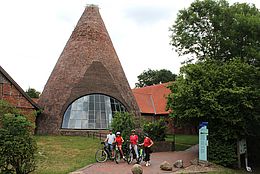
How to make glass
Sand, soda and lime - the raw materials from which glass is made have remained the same to this day. Otherwise, much has changed in glassmaking in the last 700 years since the first Wald (‘Forest’) glassworks on the Weser. In Petershagen, on the banks of the Weser, lies Gernheim, a factory from the early 19th century.
The monumental conical tower is typical of a glassworks of the 19th century, which was for a time one of the most important factories in north-western Germany. As the location of the LWL Industrial Museum, the Gernheim glassworks primarily documents the living and working conditions of the early industrial age. Visitors can watch glassmakers at work on a daily basis. Glassmakers make jars and bottles with their pipes from a glowing hot mass, just like they did 100 years ago. A grinder and engraver refines the glasses after cooling. The pieces are sold in the museum shop.
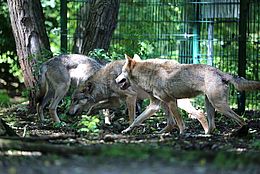 © Knut Diers
© Knut Diers Close to the wolves
Three groups of wolves of various species live in secure enclosures in the wooded outdoor area of the Dörverden Wolf Center, two of which were raised by hand. Each enclosure has a viewing platform and every two hours there is a tour that provides expert information on the biology and ecology of the wolves. Daily feedings complete the experience.
The exhibition uses specimens and photographs to provide insights into the lives of these animals. The tree house hotel, the "Tree Inn", offers special overnight accommodation five meters above the ground overlooking the wolves.
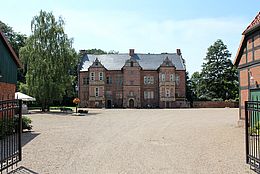
A building in the style of the Weser Renaissance
The Erbhof is an old manor house, which is one of the outstanding sights in the municipality of Thedinghausen. The Schloss was built by the Archbishop of Bremen, Johann Friedrich, in 1619/20 for his mistress, the young widow of the archbishop-Droste von Hermeling, Gertrud von Hermeling-Heimbruch
The magnificent building, in the style of the Late Weser Renaissance, was constructed in red bricks with white mortar joints. Yellow sandstone was used for the decorations. Windows, door arches, tower gables and ornamental pillars are well proportioned and skilfully designed. Sadly, Gertrud von Hermeling-Heimbruch died two years after the inauguration of this magnificent building. Today, various art and cultural events and civil ceremonies take place on the site. There is also an exhibition on the Erbhof.
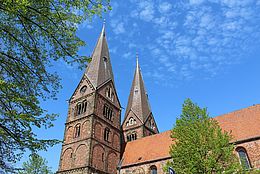
The "Bücker Cathedral"
The "Bücker Cathedral", as it is popularly called, has a varied history behind it. The stone building was erected from 1050 to replace an old wooden mission church that was built in 882 by Rimbert, Bishop of Bremen. In several stages, the monastic church was expanded up until the year 1350. In the course of the secularization of the monastery following the Reformation it began a structural decline, before a thorough restoration was carried out by Adalbert Hotzen between1863 to 1867. Named after St. Maternian and later also dedicated to St. Nicholas, the lives of these saints are depicted in the medieval windows. The art history of the collegiate church makes it one of the most important sacred buildings in the Middle Weser region. It is about 50 m long, 25 m wide, the towers are a lofty 52 m high.